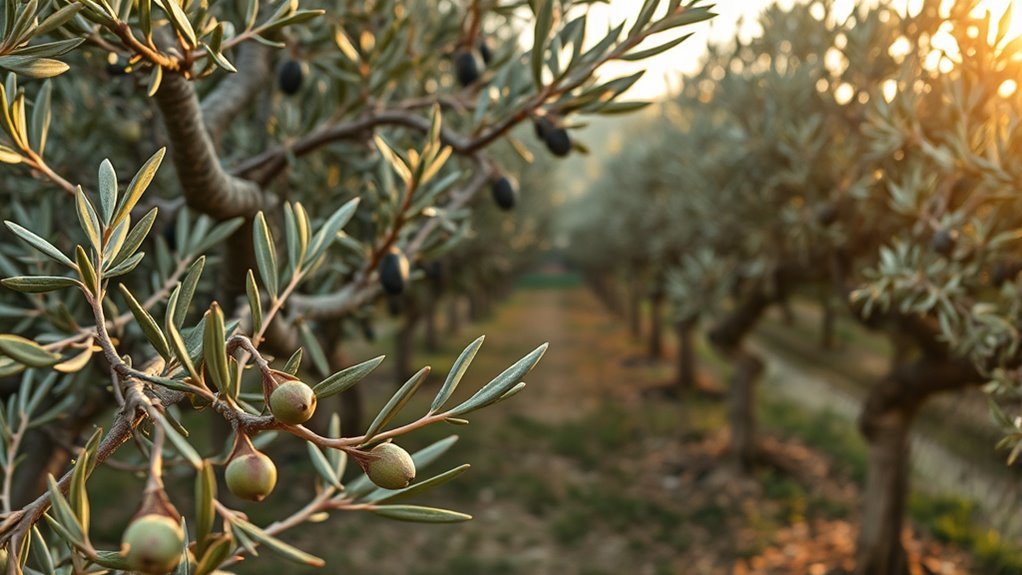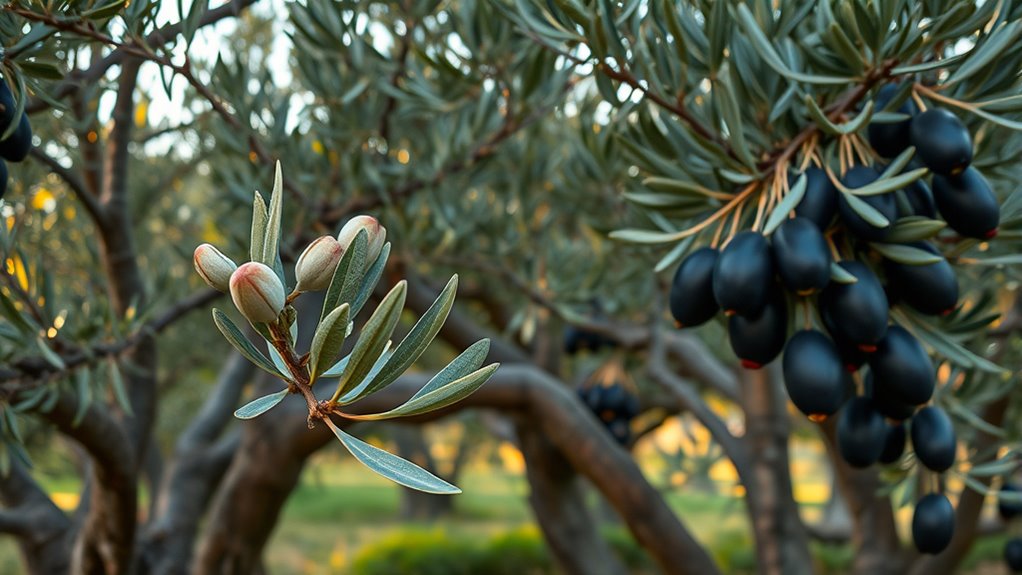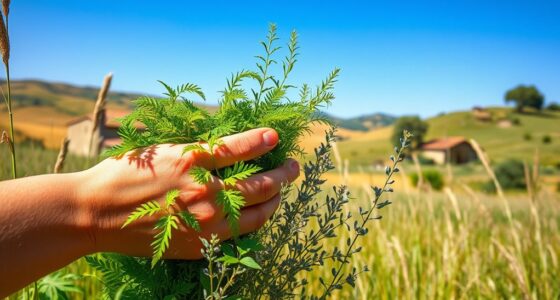To guide your olive tree from bud to bottle, you start by selecting a suitable site with good sunlight and soil. Next, you manage pruning, pest control, and fertilization to keep trees healthy. Throughout the cycle, proper irrigation and disease prevention ensure good growth. During harvest, timing is key, and careful handling preserves fruit quality. Finally, pressing the olives produces high-quality oil. To discover detailed steps for each phase, continue exploring the full cultivation process.
Key Takeaways
- Select optimal site conditions and prepare soil to support healthy olive tree growth.
- Implement regular pruning, fertilization, and pest control to maintain tree health and productivity.
- Manage irrigation carefully and monitor for diseases to ensure optimal growth and fruit quality.
- Harvest olives at peak ripeness using proper techniques to prevent damage and preserve quality.
- Conduct post-harvest handling and processing promptly to produce high-quality olive oil from the harvested fruit.

The olive tree cultivation cycle is a carefully managed process that guarantees healthy growth and ideal fruit production. To succeed, you need to pay close attention to every stage, especially during olive harvesting and orchard management. Proper orchard management begins with selecting the right location and soil conditions, ensuring your trees have excellent access to sunlight, drainage, and nutrients. Regular pruning helps shape the trees, removing dead or overcrowded branches that could hinder airflow and sunlight penetration. This not only promotes better fruit development but also reduces disease risks. As your trees mature, it’s essential to monitor their health continuously, applying fertilization when needed to supply necessary nutrients for vigorous growth.
When the time comes for olive harvesting, timing is paramount. You want to pick the olives at their peak ripeness to maximize oil quality and yield. The harvesting process varies depending on the olive variety and intended use, but it often involves manual picking or mechanical methods. During harvest, you must handle the fruit carefully to prevent bruising or damage, which can affect the oil’s flavor and quality. Once harvested, promptly transporting the olives to the mill minimizes deterioration and preserves their freshness. This step highlights the importance of efficient orchard management—organizing your harvest schedule and logistics to guarantee swift processing. Additionally, implementing proper orchard practices such as pest control and disease prevention can greatly enhance overall yield and quality.
Throughout the cultivation cycle, maintaining consistent orchard management practices helps maximize production. This includes pest control, disease prevention, and weed management, all tailored to your specific environment. Pest infestations or disease outbreaks can greatly reduce yields and compromise fruit quality, so early detection and targeted interventions are critical. Furthermore, managing irrigation efficiently ensures your trees receive adequate water—especially during dry periods—without overwatering, which can lead to root problems.
As the olives approach maturity, your focus shifts toward preparing for the next phase—processing. Proper orchard management during the entire cycle means you’re better equipped to handle fluctuations in weather and pest pressures, ultimately leading to a successful harvest. When you combine attentive orchard management with timely olive harvesting, you’re setting the stage for producing high-quality olive oil or table olives. The entire cultivation cycle depends on your ability to oversee these processes carefully, ensuring each step flows seamlessly into the next, resulting in a healthy orchard and a bountiful harvest.
Frequently Asked Questions
How Does Climate Affect Olive Tree Growth?
Climate greatly influences your olive tree growth. In different climate zones, temperature fluctuations can impact flowering and fruit production. Warmer zones promote faster growth, while cold temperatures may cause damage or dormancy. You need to take into account local climate conditions to guarantee ideal development. Properly managing water and protecting trees from extreme temperature changes helps maintain healthy growth and quality olives, regardless of the climate zone.
What Pests Commonly Threaten Olive Orchards?
You should know that pests like olive fruit flies, olive moths, and scale insects commonly threaten olive orchards. Effective pest identification is vital to spotting issues early. Implement pest management strategies such as regular monitoring, natural predators, and targeted treatments to control infestations. By staying vigilant and proactive, you can protect your olive trees, ensuring healthy growth and a successful harvest without significant damage from pests.
How Long Does It Take for an Olive Tree to Produce Fruit?
You’ll find that an olive tree usually takes about 3 to 5 years to produce fruit, but this varies with the tree’s variety and growing conditions. The harvest timing depends on fruit maturation, which occurs as the olives change color and reach ideal ripeness. Keep an eye on these signs to determine when to harvest for the best flavor and oil quality, ensuring you get a good yield from your orchard.
What Are Sustainable Practices in Olive Cultivation?
Ever wondered how you can grow olives responsibly? Sustainable practices like water conservation and maintaining soil health are key. You can reduce water use by drip irrigation and mulching, while enriching the soil with organic compost boosts long-term robustness. These steps not only protect the environment but also ensure your olives thrive year after year. The secret? Consistent care and mindful resource management—your olives will thank you with quality harvests.
How Is Olive Oil Quality Assessed During Production?
You assess olive oil quality through grading and sensory evaluation. You check olive oil grading to classify it based on standards like acidity and purity. Sensory evaluation involves tasting and smelling the oil for aroma, flavor, and overall harmony. By combining these methods, you guarantee the oil meets quality standards, helping consumers enjoy the best possible product. This process guarantees that only high-quality olive oil reaches the market.
Conclusion
You nurture the soil, you care for the buds, you harvest the olives, and you produce the oil. You follow each step with patience, dedication, and passion. You embrace the cycle from bud to bottle, understanding that every stage matters. You respect the tradition, cherish the process, and celebrate the harvest. In this journey, you connect with nature, honor the craft, and enjoy the fruits of your labor. Because in every drop, you find the essence of the olive tree.









